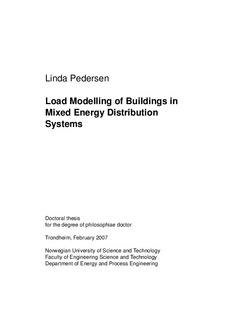| dc.contributor.author | Pedersen, Linda | nb_NO |
| dc.date.accessioned | 2014-12-19T11:43:32Z | |
| dc.date.available | 2014-12-19T11:43:32Z | |
| dc.date.created | 2007-06-29 | nb_NO |
| dc.date.issued | 2007 | nb_NO |
| dc.identifier | 122458 | nb_NO |
| dc.identifier.isbn | 978-82-471-1724-8 | nb_NO |
| dc.identifier.uri | http://hdl.handle.net/11250/233327 | |
| dc.description.abstract | The main topic of this thesis has been the development of a new method for load modelling of buildings in mixed energy distribution systems. The method estimates design load profiles, yearly load profiles, load duration profiles and annual expected energy demand for a specified planning area, all divided into heat and electricity purposes. The heat load demand includes end-uses such as space heating, ventilation heating and hot tap water, while electricity load demand includes end-uses such as lighting, pumps, fans, and electrical appliances.
The model has been based on statistical analyses of simultaneous hourly district heat and electricity consumption data for a number of buildings. Consumption data have been collected from TEV Fjernvarme and BKK Varme, two district heating companies in Trondheim and Bergen respectively.
The heat load model has been based on piece-wise linear regression analyses to estimate the change-point temperature for temperaturedependent heat consumption. Linear regression analyses have been performed on the temperature-dependent consumption for all hours of the day for two different day types, weekdays and weekends/holidays. The normal distribution has been used on the temperature-independent consumption, which is mainly hot tap water. Expected values and standard deviations for all buildings analysed have been calculated for both temperature-dependent and temperature-independent consumption.
The electricity load model has been based on continuous probability distributions, such as normal distribution, lognormal distribution and Student’s t distribution. The last distribution has shown the best fit for all hours and day types in most cases. Expected values and standard deviations for all buildings analysed have been calculated for winter, spring/fall and summer seasons.
Generalised relative load profiles have been developed for various building categories based on the heat and electricity load model. Single family houses and apartment blocks, office buildings, educational buildings, hospital buildings, and hotels and restaurants are the building categories that have been analysed. Specific heat and electricity load and energy indicators, given in [W/m2] and [ kWh/m2], have also been developed for all building categories. The specific load indicators have been used to restore the design load profiles from relative to real values in order to find the maximum heat and electricity demand for a specified planning area. The specific energy indicators have been used to convert the normalised yearly load profiles, and consequently, the normalised load duration profiles into real values.
A method for load aggregation for a specified planning area has also been developed based on the sum of independent variables from the same distribution. 95% quantile analysis based on the Student’s t distribution has been applied to incorporate the uncertainty in the load profiles developed. The installed capacity, and thereby the investment costs for the energy production unit(s) and distribution system(s), are decided by the design load profiles and load duration profiles. The system’s operation costs are given by the yearly load profiles and annual expected energy demand.
A theoretical case study has been performed to illustrate how to apply the generalised relative load profiles, along with the specific load and energy indicators, for the purpose of planning for mixed energy distribution systems. | nb_NO |
| dc.language | eng | nb_NO |
| dc.publisher | Fakultet for ingeniørvitenskap og teknologi | nb_NO |
| dc.relation.ispartofseries | Doktoravhandlinger ved NTNU, 1503-8181; 2007:78 | nb_NO |
| dc.relation.haspart | Pedersen, Linda. Use of different methodologies for thermal load and energy estimations in buildings including meteorological and sociological input parameters. Renewable and Sustainable Energy Review. 11(5): 998-1007, 2007. | nb_NO |
| dc.title | Load Modelling of Buildings in Mixed Energy Distribution Systems | nb_NO |
| dc.type | Doctoral thesis | nb_NO |
| dc.contributor.department | Norges teknisk-naturvitenskapelige universitet, Fakultet for ingeniørvitenskap og teknologi, Institutt for energi- og prosessteknikk | nb_NO |
| dc.description.degree | PhD i energi- og prosessteknikk | nb_NO |
| dc.description.degree | PhD in Energy and Process Engineering | en_GB |
